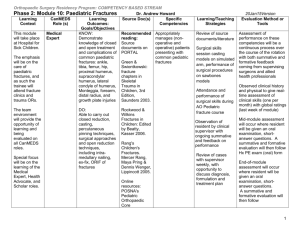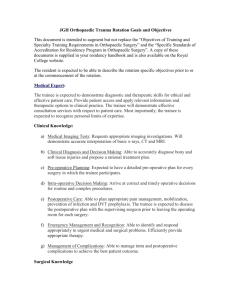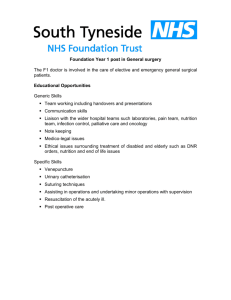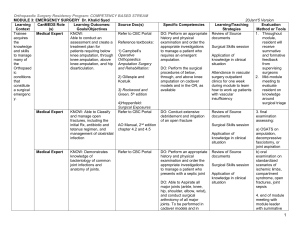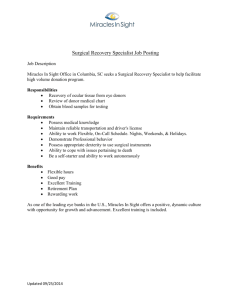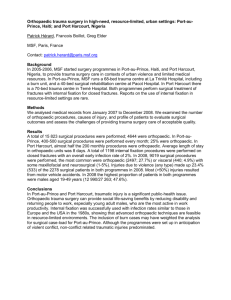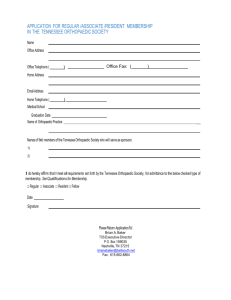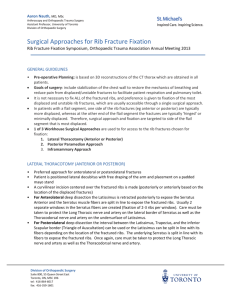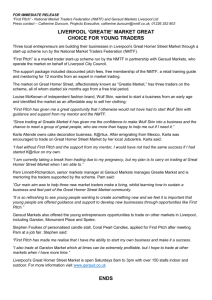Module 1 - Curriculum Map
advertisement
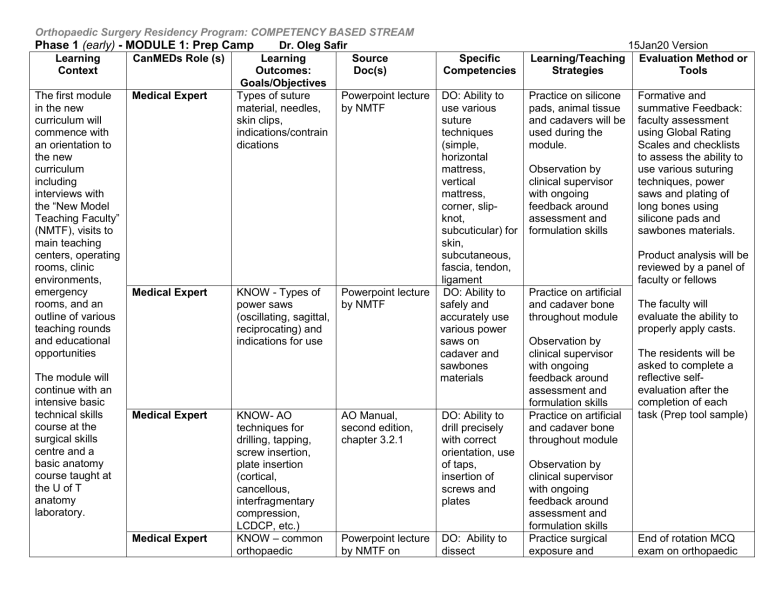
Orthopaedic Surgery Residency Program: COMPETENCY BASED STREAM Phase 1 (early) - MODULE 1: Prep Camp Dr. Oleg Safir Learning CanMEDs Role (s) Learning Source Context Outcomes: Doc(s) Goals/Objectives Medical Expert The first module Types of suture Powerpoint lecture in the new material, needles, by NMTF curriculum will skin clips, commence with indications/contrain an orientation to dications the new curriculum including interviews with the “New Model Teaching Faculty” (NMTF), visits to main teaching centers, operating rooms, clinic environments, emergency Medical Expert KNOW - Types of Powerpoint lecture rooms, and an power saws by NMTF outline of various (oscillating, sagittal, teaching rounds reciprocating) and and educational indications for use opportunities The module will continue with an intensive basic technical skills course at the surgical skills centre and a basic anatomy course taught at the U of T anatomy laboratory. Medical Expert Medical Expert KNOW- AO techniques for drilling, tapping, screw insertion, plate insertion (cortical, cancellous, interfragmentary compression, LCDCP, etc.) KNOW – common orthopaedic AO Manual, second edition, chapter 3.2.1 Powerpoint lecture by NMTF on Specific Competencies DO: Ability to use various suture techniques (simple, horizontal mattress, vertical mattress, corner, slipknot, subcuticular) for skin, subcutaneous, fascia, tendon, ligament DO: Ability to safely and accurately use various power saws on cadaver and sawbones materials DO: Ability to drill precisely with correct orientation, use of taps, insertion of screws and plates DO: Ability to dissect 15Jan20 Version Learning/Teaching Evaluation Method or Strategies Tools Practice on silicone pads, animal tissue and cadavers will be used during the module. Observation by clinical supervisor with ongoing feedback around assessment and formulation skills Formative and summative Feedback: faculty assessment using Global Rating Scales and checklists to assess the ability to use various suturing techniques, power saws and plating of long bones using silicone pads and sawbones materials. Product analysis will be reviewed by a panel of faculty or fellows Practice on artificial and cadaver bone throughout module Observation by clinical supervisor with ongoing feedback around assessment and formulation skills Practice on artificial and cadaver bone throughout module Observation by clinical supervisor with ongoing feedback around assessment and formulation skills Practice surgical exposure and The faculty will evaluate the ability to properly apply casts. The residents will be asked to complete a reflective selfevaluation after the completion of each task (Prep tool sample) End of rotation MCQ exam on orthopaedic Learning Context CanMEDs Role (s) These courses will be taught by the NMTU faculty making use of models, cadavers, prosected specimens and virtual reality trainers to master various objectives Medical Expert Learning Outcomes: Goals/Objectives surgical exposures of the upper and lower extremity KNOW – basic principles and application of upper and lower extremity casts/splints KNOW – interpretation and diagnosis of fractures using plain film radiographs Professional Knowledge of: Appropriate Behaviours in clinical setting Source Doc(s) Specific Competencies Learning/Teaching Strategies Evaluation Method or Tools anatomy and surgical exposure of each body part (e.g. shoulder, elbow etc) cadavers using surgical instruments for surgical exposures. identifying important anatomical structures during the dissection (e.g. vessels and nerves) anatomy and surgical exposures Orthopaedic surgical exposure textbook by S. Hoppenfeld Know relevant exposure and key anatomical structures for specific fracture fixation cases Observation by clinical supervisor with ongoing feedback during anatomy session DO: Ability to apply different types of casts and splints for fractures. Residents will practice on each other using several common casting and splinting techniques with the supervision of a cast tech and an orthopaedic surgeon Powerpoint lecture on the application of casts/splints MSK radiology staff or fellow to provide lecture on the approach, interpretation and analysis of common orthopaedic fractures using plain film radiographs 1. PGCorEd Professional Module Demonstration of the correct reduction maneuver and molding technique for specific fractures The faculty will evaluate the ability to properly apply casts and to interpret fractures from plain film radiographs. (Using GRS and checklists) Observation by staff while reviewing a library of MSK radiology films DO: Ability to accurately diagnose and interpret common fractures using plain film radiographs Exhibit professional behaviors in practice, On-line computer simulated module with interactive video and quizzes Completion of Module by end of module – pass/fail Learning Context CanMEDs Role (s) Learning Outcomes: Goals/Objectives Appropriate relations with patients The legal and regulatory frameworkavoiding trouble Source Doc(s) 2. CanMEDS Framework http://rcpsc.medica l.org/canmeds/bes tpractices/framew ork_e.pdf Specific Competencies including honesty, integrity, commitment, compassion, respect and altruism 3. Lecture notes on Demonstrate a Professionalism / commitment to Surgical delivering the Planning Work/life balance highest quality to maintain health care Recognize and appropriately respond to ethical issues encountered in orthopedic practice Appropriately manage conflicts of interest with colleagues/pati ents/clerks Learning/Teaching Strategies Evaluation Method or Tools On-going review/self study Formative feedback from supervising surgeon Observation by supervisors, peers on interaction with team members, patients and interprofessional staff; Observation of resident’s ability to pose an appropriate learning questions in the proper environment and context Final summative skills test using cadavers
